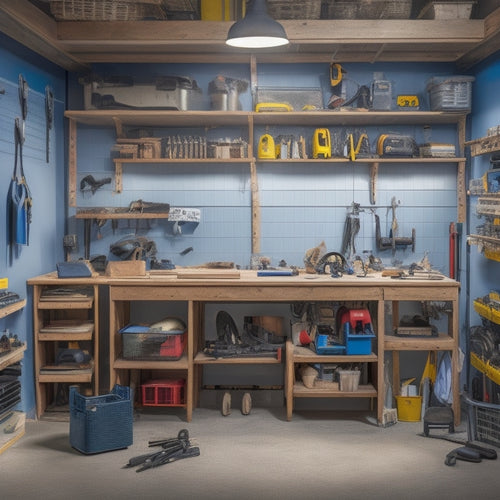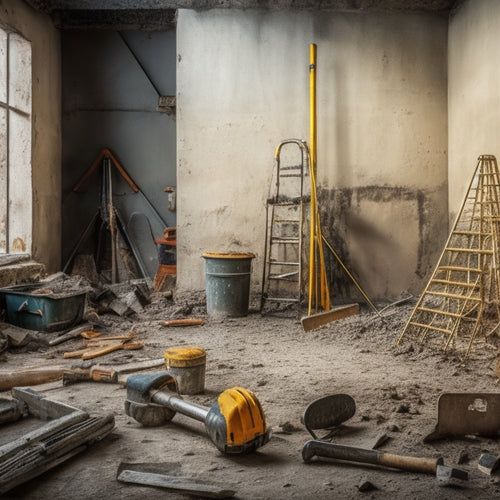
Top Demolition Tools for DIY Home Renovations
Share
When tackling a DIY home renovation, you'll need the right demolition tools to get the job done safely and efficiently. Start with essential safety gear like personal protective equipment, sledgehammers, and pry bars for wall demolition. Hammer drills and reciprocating saws are perfect for heavy-duty tasks, while jackhammers and demolition forks are ideal for concrete removal and flooring removal. Don't forget circular saws for precise cuts and wrecking bars for heavy lifting. By selecting the right tools and following proper techniques, you'll be well on your way to a successful renovation - and there's more to discover about each of these tools.
Key Takeaways
• Essential safety gear includes personal protective equipment, safety goggles, durable gloves, and dust masks to prevent injuries.
• Sledgehammers, pry bars, hammer drills, reciprocating saws, and jackhammers are top demolition tools for DIY home renovations.
• Choose the right tool for the job, considering factors like wall type, material, and required force to ensure effective demolition.
• Demolition techniques, such as swing techniques for sledgehammers and controlled cuts for reciprocating saws, are crucial for efficient and safe demolition.
• Always prioritize safety by assessing the demolition zone, wearing protective gear, and verifying power shut-off to avoid electrical shock hazards.
Essential Safety Gear for Demolition
Wear personal protective equipment (PPE) like gloves, safety glasses, and a dust mask to shield yourself from debris and hazardous materials during demolition.
You're about to take down walls, rip out flooring, and smash through ceilings - it's vital to prioritize your safety above all else.
Safety goggles will protect your eyes from flying particles, while hard hats will absorb impact from falling objects.
Don't overlook the importance of durable gloves, which will prevent cuts and abrasions on your hands.
A dust mask will filter out airborne particles, keeping your respiratory system safe from harm.
Remember, demolition can get messy and unpredictable, so it's important to be prepared.
Invest in high-quality PPE that meets industry standards, and make sure you're comfortable wearing it for extended periods.
Demolishing Walls With Sledgehammers
When you're ready to take down a wall with a sledgehammer, you'll need to master the right swing techniques to avoid fatigue and maximize impact.
You'll also need to evaluate the type of wall you're dealing with, as different materials require distinct approaches.
Swing Techniques Matter
You'll need to develop a deliberate swing technique to efficiently demolish walls with a sledgehammer, as haphazard blows can lead to wasted energy and uneven destruction.
Mastering swing mechanics is essential to delivering effective swings that can take down walls quickly and safely.
Start by gripping the sledgehammer with both hands, one hand at the end of the handle and the other about halfway down. This will give you balance and control.
As you swing, keep your back straight, engage your core, and generate power from your legs. Aim for the center of the wall, using a slight arc to your swing to maximize impact.
Focus on using your hips and legs to generate force, rather than just your arms.
With each swing, aim to hit the same spot, using the weight of the sledgehammer to do the work for you.
Wall Type Considerations
Mastering the swing technique is just the beginning, as the type of wall you're facing can greatly impact the effectiveness of your sledgehammer demolition.
You'll need to evaluate the wall materials and their characteristics to optimize your demolition strategy. For instance, drywall thickness plays a significant role in determining the amount of force required to bring it down. Thicker drywall may require more powerful swings, while thinner sheets can be taken down with less force.
When dealing with wood-framed walls, you'll need to be mindful of the studs, as they can provide additional structural integrity. In such cases, it's crucial to target the areas between the studs to avoid damaging the surrounding framework.
On the other hand, metal-studded walls may require a more aggressive approach, as the metal studs can be more challenging to break through.
Understanding the composition of the wall you're facing will enable you to adjust your technique and choose the right demolition tool for the job.
Safety First Always
Before you start swinging a sledgehammer, take a moment to assess the demolition zone, confirming a clear path to the wall and a safe escape route from the debris. Demolition site safety is vital, and hazard awareness is key to avoiding accidents.
| Hazard | Precaution |
|---|---|
| Debris Falling | Wear hard hat, safety glasses, and a dust mask |
| Electrical Shock | Verify power is shut off to the area |
| Structural Collapse | Check for weak points in the wall before demolition |
| Noise Exposure | Wear earplugs or earmuffs to protect your hearing |
| Slip and Fall | Clear the area of tripping hazards and confirm good footing |
Pry Bars for Easy Removal
When tackling DIY home renovations, a sturdy pry bar is an essential tool for effortlessly removing old fixtures, trim, and molding without damaging surrounding surfaces.
You'll want to choose a pry bar made from durable materials, such as high-carbon steel or fiberglass, that can withstand the rigors of demolition.
Consider a pry bar with a comfortable grip and a curved or angled end, which allows for better leverage and control.
Mastering pry bar techniques is fundamental for efficient removal.
Start by inserting the pry bar between the fixture and the surface, then gently pry it loose.
Apply steady pressure, using your body weight to help dislodge the fixture.
For tougher removals, try using a fulcrum point, such as a block of wood, to amplify your force.
Remember to work slowly and carefully to avoid damaging surrounding surfaces.
With the right pry bar and techniques, you'll be able to remove old fixtures with ease, making way for your new renovation vision.
Hammer Drills for Heavy Duty
As you move on to more substantial demolition tasks, you'll need a hammer drill that can handle heavy-duty projects, such as breaking up concrete or busting through thick walls. A hammer drill's ability to deliver high-torque and high-impact forces makes it an essential tool for any serious DIY renovation.
When selecting a hammer drill, consider the following key features:
-
Power: Look for drills with high wattage or amp ratings to guarantee they can handle demanding tasks.
-
Speed: Variable speed control allows you to adjust the drill's speed to suit the material you're working with.
-
Ergonomics: A comfortable grip and balanced design reduce fatigue during extended use.
-
Hammer drill features: Some models come with built-in LED lights, adjustable handles, or specialized chuck systems.
-
Hammer drill maintenance: Regularly clean and lubricate your drill to extend its lifespan and maintain performance.
Reciprocating Saws for Demolition
When you're tackling demolition tasks, a reciprocating saw is an essential tool to have in your arsenal.
You'll need to choose the right saw blade for the job, considering factors like material type and thickness.
Then, master the techniques that'll help you make precise cuts and demolish with ease.
Saw Blade Selection
You'll need to choose the right saw blade for your reciprocating saw to effectively tackle demolition tasks, such as tearing down walls or cutting through pipes. The right blade can make all the difference in your DIY home renovation project.
When selecting a saw blade, consider the following factors:
-
Blade materials: Carbon steel blades are ideal for general-purpose demolition, while bi-metal blades offer a longer lifespan and can handle tougher materials like metal pipes.
-
Blade types: Demo blades with aggressive tooth patterns are perfect for tearing down walls, while precision blades with finer tooth patterns are better suited for cutting pipes or metal studs.
-
Blade thickness: Thicker blades provide more stability and are suitable for heavy-duty demolition, while thinner blades are more flexible and ideal for curved cuts or tight spaces.
-
Tooth count: Blades with more teeth per inch (TPI) provide a smoother cut, while those with fewer TPI are better for rough demolition work.
-
Coatings: Look for blades with specialized coatings, such as titanium or diamond, for improved durability and heat resistance.
Demolition Techniques
With your reciprocating saw and chosen blade in hand, start demolition by making controlled, aggressive cuts into the material, using a gentle to moderate pressing force to maintain blade speed and prevent kickback. This technique allows you to make precise cuts while minimizing the risk of damage to surrounding structures.
As you work, remember to keep your body positioned at a safe distance from the cutting area, and always wear proper protective gear, including safety glasses and gloves.
Before you begin, take the time to assess the structural integrity of the material you're about to demolish. This critical step in demolition planning will help you identify potential weak points and avoid causing unintended damage.
A thorough structural assessment will also help you determine the best approach for the demolition, ensuring you use the right techniques and tools for the job.
Jackhammers for Concrete Removal
To tackle concrete removal tasks efficiently, you'll need a reliable jackhammer that can deliver the necessary force to break up and dislodge stubborn concrete surfaces. A good jackhammer will make quick work of even the toughest concrete, saving you time and energy in the process.
When choosing a jackhammer, consider the following key factors:
-
Weight and balance: Look for a jackhammer that's well-balanced and easy to maneuver, even in tight spaces.
-
Power output: Choose a jackhammer with a high power output (measured in pounds per square inch) to tackle tough concrete surfaces.
-
Bit type and quality: Select a jackhammer with high-quality bits that are designed for your specific concrete removal task.
-
Vibration control: Opt for a jackhammer with built-in vibration control to reduce fatigue and improve handling.
-
Maintenance and safety features: Consider a jackhammer with easy maintenance features, such as a removable air filter, and safety features like a trigger lock to prevent accidental start-ups.
Demolition Forks and Claw Bars
Demolition forks and claw bars are essential tools for prying, pulling, and dismantling materials during DIY home renovations, allowing you to efficiently disassemble structures and remove debris. These heavy-duty tools help you tackle tough demolition tasks with ease.
Demolition forks, also known as wrecking bars or pry bars, are long, flat bars with a curved or angled end. They're perfect for prying open walls, removing flooring, and breaking up wood and drywall.
Claw bars, on the other hand, feature a curved or angled end with a claw-like design. They're ideal for gripping and pulling materials apart, such as demoing cabinets, countertops, and roofing.
When choosing a demolition fork or claw bar, consider the weight, length, and material. Look for tools made from high-quality steel or fiberglass, which provide durability and strength.
You'll also want to select a fork or bar that's the right size for your project, as this will guarantee maximum leverage and control. With the right demolition fork or claw bar in your toolbox, you'll be able to tackle even the toughest DIY renovation projects with confidence.
Circular Saws for Cutting
You'll rely heavily on circular saws to make precise cuts in various materials, from wood and metal to drywall and plaster, during your DIY home renovation project.
These powerful tools are vital for demolishing walls, cutting through pipes, and making precise cuts in flooring.
To get the most out of your circular saw, it's important to perform regular circular saw maintenance, including cleaning the blade and motor, checking the cord for damage, and replacing worn-out parts.
Here are some essential circular saw accessories to keep in mind:
-
Blade guards to protect yourself from kickback and debris
-
Dust-collecting attachments to minimize mess and improve visibility
-
Rip guides to guarantee straight cuts and prevent accidents
-
Diamond blades for cutting through tough materials like concrete and tile
-
Carrying cases to store and transport your saw safely
Wrecking Bars for Heavy Lifting
When tackling heavy lifting and prying tasks during your DIY home renovation, a wrecking bar is an indispensable tool that helps you apply massive force with minimal effort. This versatile tool is designed to provide maximum leverage, allowing you to lift, pry, and demolish heavy objects with ease.
As a DIY renovator, you'll find wrecking bars essential for various applications, including removing flooring, breaking up concrete, and dislodging stubborn fixtures.
To get the most out of your wrecking bar, it's vital to master heavy lifting techniques. Start by positioning the bar correctly, using the fulcrum point to amplify your force. Then, use your body weight to generate power, keeping your back straight and your arms locked.
Apply slow, controlled pressure to avoid losing grip or slipping. By combining the right technique with a high-quality wrecking bar, you'll be able to tackle even the toughest demolition tasks with confidence.
With the right tool and technique, you'll be amazed at what you can accomplish.
Frequently Asked Questions
Can I Rent Demolition Tools Instead of Buying Them?
You're smart to take into account renting demolition tools instead of buying them.
This approach can be a cost-effective option, especially if you only need a specific tool for a one-time project.
When renting, research local equipment rental shops, compare prices, and ask about any discounts or promotions.
Also, be certain to inspect the tool before taking it home to verify it's in good condition.
With these tool rental tips, you'll be ready to tackle your demolition project without breaking the bank.
How Do I Dispose of Demolition Waste and Debris?
Coincidentally, you're taking a responsible approach to your DIY project by thinking about waste disposal. You're on the right track!
Now, focus on responsible debris management. Sort recyclable materials from non-recyclables, and consider partnering with a waste recycling service.
Make sure you dispose of hazardous materials like asbestos and lead paint according to local regulations. You got this!
Proper waste management won't only save you money but also reduce your environmental footprint.
Are There Any Specific Demolition Tools for Tile Removal?
When tackling tile removal, you'll want to employ the right techniques and tools for the job.
For efficient tile removal, you'll need a sturdy scraper or an oscillating multi-tool with a grout blade attachment.
Don't forget the best tile chisels, such as a hammer and chisel set or a tile scraper with a carbide-tipped edge.
These will help you pry up tiles without damaging the underlying surface.
Can I Use Demolition Tools on Load-Bearing Walls Safely?
Did you know that 70% of DIY renovation projects involve load-bearing wall modifications?
When tackling these critical structures, you must prioritize load-bearing wall safety above all. You can't afford to compromise the integrity of your home.
When selecting demolition tools, opt for precision instruments designed for controlled, calculated destruction. Avoid using heavy-duty tools that can cause unintended damage.
Instead, choose tools that allow for deliberate, targeted removal to guarantee a safe and successful renovation.
Do I Need a Permit for DIY Demolition Projects in My Area?
You're likely wondering if you need a permit for your DIY demolition project.
Check your local regulations to determine the permit requirements in your area. Don't assume you can skip this step - it's essential to guarantee you're complying with local laws.
You'll need to research the specific rules governing demolition projects and obtain the necessary permits before starting the job.
Failure to do so can result in fines, penalties, or even project shutdowns.
Conclusion
You've made it to the final stage of your DIY demolition journey, armed with the top tools for the job.
Now, it's time to put them to work, like a conductor leading an orchestra. With these essential tools, you'll be able to tackle any demolition task with confidence and precision.
Remember to stay safe, plan ahead, and don't be afraid to get your hands dirty.
Your DIY home renovation is just a demo away from transformation!
Related Posts
-

Top Tools for DIY Home Renovation Plastering Success
To achieve DIY home renovation plastering success, you'll need a range of essential tools. Start with hand tools like...
-

Why Home Renovators Need Smart Tool Storage Now
You need a smart tool storage system that streamlines your workflow, reduces clutter, and protects your investments b...
-

What Tools to Rent for Block Wall Renovation
When renovating a block wall, it's vital to have the right tools for the job. You'll need demolition tools like pry b...


